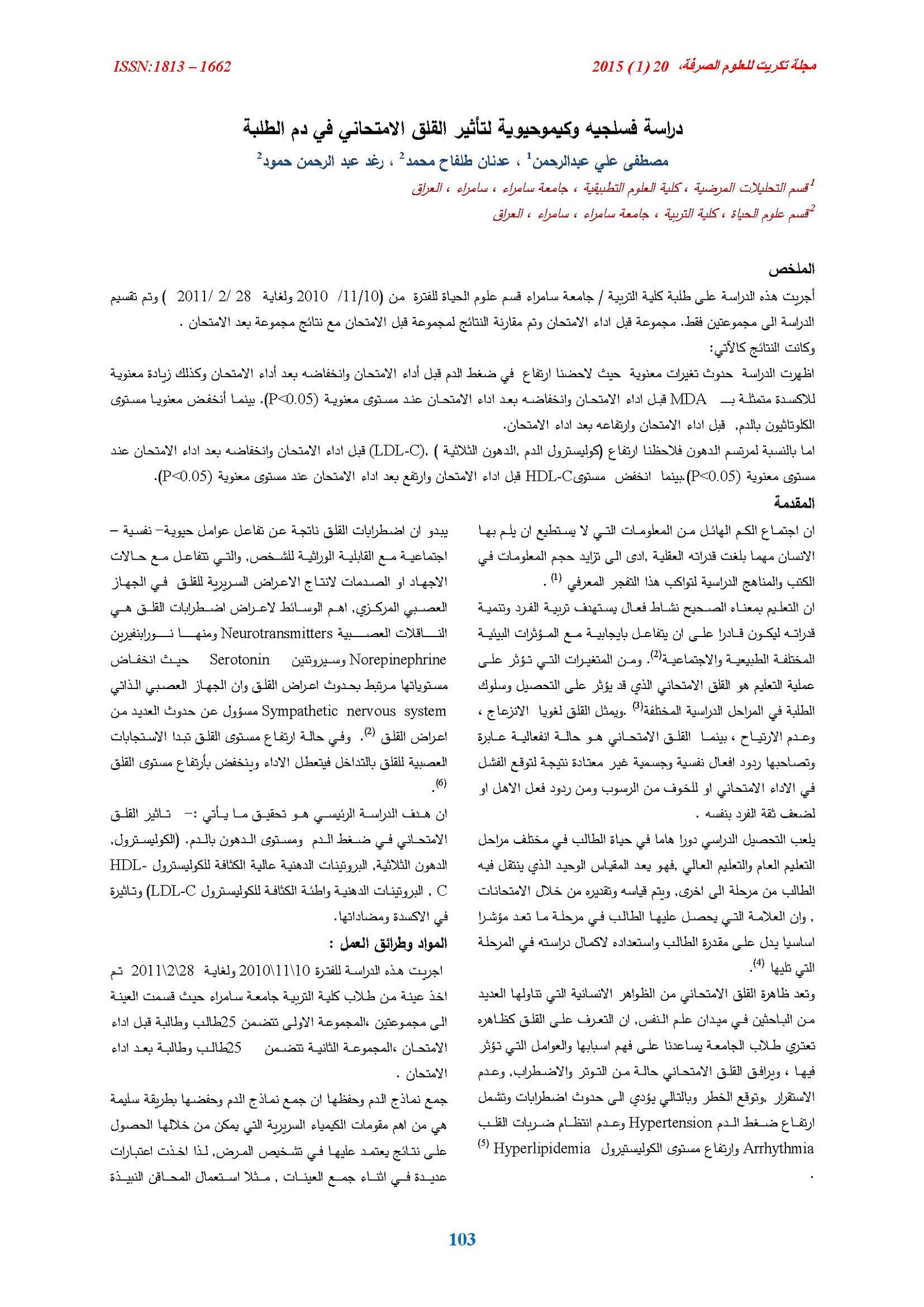Physiological and biochemical study of the effect of Anxiety exam in the blood of students.
Main Article Content
Abstract
This study was conducted on the students of the Faculty of Education / University of Samarra, Department of biology for the period of (10/ 11/ 2010 to 28/02/2011 ) study were divided into two groups only . Set before performing the exam results were compared to a group before the exam results with a group after the exam.
The results were as follows.
The study showed significant changes in terms in high blood pressure before the exam performance and exam performance after falling as well as significantly increased antioxidant represented by MDA before performing the exam and exam performance after falling at the level of significance (P<0.05).While the level was significantly lower Glutathieion before performing the exam and height after performing the exam.
As for the lipid profile ( blood cholesterol , triglycerides ), (LDL-C) before performing the exam and its decline after performing the exam at the level of significance(P <0.05). While the level of HDL-C by performing the exam rose after performing the exam at the level of significance( P <0.05).
Article Details

This work is licensed under a Creative Commons Attribution 4.0 International License.
Tikrit Journal of Pure Science is licensed under the Creative Commons Attribution 4.0 International License, which allows users to copy, create extracts, abstracts, and new works from the article, alter and revise the article, and make commercial use of the article (including reuse and/or resale of the article by commercial entities), provided the user gives appropriate credit (with a link to the formal publication through the relevant DOI), provides a link to the license, indicates if changes were made, and the licensor is not represented as endorsing the use made of the work. The authors hold the copyright for their published work on the Tikrit J. Pure Sci. website, while Tikrit J. Pure Sci. is responsible for appreciate citation of their work, which is released under CC-BY-4.0, enabling the unrestricted use, distribution, and reproduction of an article in any medium, provided that the original work is properly cited.
References
7-Burtis,C.A and Ashwood, E.R. (1999). Textbook of Clinical Chemistry. 3rd ed. W. B. Saunders Company, Tokyo. pp.: 1034-1054.
8-Sheu, J.Y.; Ku, H.P.; Tseng ,W.C.; and Chen ,M.T.(2003). Determination of thiobarbituric acid adduct of malondialdehyde using on line micro dialysis coupled with high performance liquid chromatography . 19:621 – 624.
9-Muslih, R.K.; AL- Nimer, M.S. and AL – Zamely, O.M.Y. (2002). The level of malondialdehyde after activition with (H2O and CuSO4) and inhibtion by disferoxamine and molsidomine in the serum patients with acute myocardial infarction. Nat .J . of Chem. 5: 139-148
14-Zellwr, A .and Carmines. E. (1986). Reliability and validity assessment. Question Application in the social. Newbury park, CA; Sage.
19- Chen , T.S.A.I.; Eei-Hsin, W.; Paul, C.; LI-Jung, L.I.N.; M.N.S C.H. I W, M.N.S.,1 Brian, T .;Ming-Hsiung, H.;. Hung-YU,Y. and JU-Chi liu. (2003). The Beneficial effects of tai chi chuan on blood pressure and lipid profile and anxiety status in a randomized controlled trial. the Journal of Alternative and Complemen Med 9, (5). 747–754.
20-Veen, G.; Giltay, E.J; DeRijk, R.H. and Zitman. F.G. (2009). Salivary cortisol, serum lipids, and adiposity in patients with depressive and anxiety disorders. Metabolism. 58( 6) : 821–827.
21-Zilva, J.F.; Pannall, P.R. and Mayne, P.D. (2001).Clinical Chemistry in diagnosis and Treatment.5th. ed.edward Arnold .Adivision of Hodders Stouguton
22- Malaguarnera, I.M; Giugno, P.; Ruello, M. Rizzo, M.P.; ANebianco ,G.; Pistone , F.B.; and Tomasello .(1998). Lipid profile variations in a group of healthy elderly and centenarians. European Review for Med and Pharmacological Sci .2:75-79
23-Mehta, K.N.; Parik, K.H.; Chag, M.C.; and Shah, V.G. (2003). Effect of treatment on homocysteine miaun cardic patient :aprospective study .Indian .J. of. Pharma. 35(5):410- 419
24-Roohafza, H.M; Sadeghi, M. Afshar, H.; Mousavi, G. and Shirani, S. (2005). Lipid Profile in Patients with major depressive disorder and generalized anxity disorder. ARYA Journal . 1(1):
25-Maghrani, M.; Lemhadri, A.; Zeggwagh, N.A. and Eddouks,M.(2004). Effect of retama on lipid metabolism in normal and recent onset diabetic rats J. of. Ethno. Pharmacol .90:323-329,
26-Rowland, T.W; Martel, L. Vanderburgh, P; Manos,T and Carkoudian, N.(1996). The influence of short-term aerobic training on blood lipids in healthy 10–12 year old children. IntJ Sports Med ;17:487–492
27-Freedman, D.S; Byers, T; Barrett, D.H; Stroup, N.E; Eaker, E and Monroe-Blum .(1996). Plasma lipid levels and psychologic characteristics in men [see comments]. AmJ Epidemiol 141:507–17.
28-Kagan, B.L; Leskin, G; Haas, B; Wilkins, J and Foy, D.(1999) Elevated lipid levels in Vietnam veterans with chronic posttraumatic stress disorder. Biol Psychiatry 45:374-7. 29-Chen ,C.C, and Hung .,T.L.(2006).Association of serum lipid profiles with depressive and anxiety disorders in menopausal women. Gung Med. J.29(3): 325-30.
30-Hayward C.(1997). Anxiety disorders and serum lipids. In:Hillbrand M, Spitz RT, editors. Lipids, health, and behavior. Washington DC: American Psychological Association; 69–79.
31-Bouayed, J.; Rammal, H., and Solimani, R. (2009). Oxidative stress and anxiety: Relation ship and cellular path ways. Lands Bioscience J.2(2):63-67.
32- Bouayed, J. (2010). Relationship Between Oxidative stress and anxiety: Emerging role of antioxidants within therapeutic or preventive approaches . Anxiety Disorders953-978.
